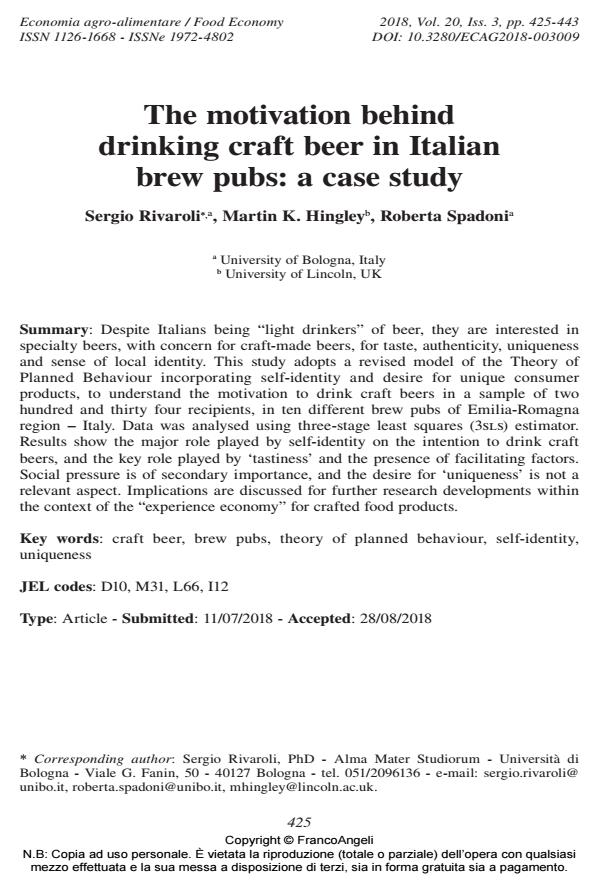The motivation behind drinking craft beer in Italian brew pubs: a case study
Titolo Rivista ECONOMIA AGRO-ALIMENTARE
Autori/Curatori Sergio Rivaroli, Martin K. Hingley, Roberta Spadoni
Anno di pubblicazione 2019 Fascicolo 2018/3
Lingua Inglese Numero pagine 19 P. 425-443 Dimensione file 180 KB
DOI 10.3280/ECAG2018-003009
Il DOI è il codice a barre della proprietà intellettuale: per saperne di più
clicca qui
Qui sotto puoi vedere in anteprima la prima pagina di questo articolo.
Se questo articolo ti interessa, lo puoi acquistare (e scaricare in formato pdf) seguendo le facili indicazioni per acquistare il download credit. Acquista Download Credits per scaricare questo Articolo in formato PDF

FrancoAngeli è membro della Publishers International Linking Association, Inc (PILA)associazione indipendente e non profit per facilitare (attraverso i servizi tecnologici implementati da CrossRef.org) l’accesso degli studiosi ai contenuti digitali nelle pubblicazioni professionali e scientifiche
Despite Italians being "light drinkers" of beer, they are interested in specialty beers, with concern for craft-made beers, for taste, authenticity, uniqueness and sense of local identity. This study adopts a revised model of the Theory of Planned Behaviour incorporating self-identity and desire for unique consumer products, to understand the motivation to drink craft beers in a sample of two hundred and thirty four recipients, in ten different brew pubs of Emilia-Romagna region - Italy. Data was analysed using three-stage least squares (3sls) estimator. Results show the major role played by self-identity on the intention to drink craft beers, and the key role played by ‘tastiness’ and the presence of facilitating factors. Social pressure is of secondary importance, and the desire for ‘uniqueness’ is not a relevant aspect. Implications are discussed for further research developments within the context of the "experience economy" for crafted food products.
Parole chiave:Craft beer, brew pubs, theory of planned behaviour, self-identity, uniqueness
Jel codes:D10, M31, L66, I12
- Factors influencing the choice of beer: A review Maria Isabel Betancur, Kosuke Motoki, Charles Spence, Carlos Velasco, in Food Research International 109367/2020 pp.109367
DOI: 10.1016/j.foodres.2020.109367 - Preference segments among declared craft beer drinkers: Perceptual, attitudinal and behavioral responses underlying craft-style vs. traditional-style flavor preferences Sara R. Jaeger, Thierry Worch, Tracey Phelps, David Jin, Armand V. Cardello, in Food Quality and Preference 103884/2020 pp.103884
DOI: 10.1016/j.foodqual.2020.103884 - Analysis of Italian craft beer consumers: preferences and purchasing behaviour Giulio Cascone, Giancarlo Tuccio, Giuseppe Timpanaro, in British Food Journal /2025 pp.914
DOI: 10.1108/BFJ-05-2024-0552 - Craft beer – a systematic literature review and research agenda Edgar Nave, Paulo Duarte, Ricardo Gouveia Rodrigues, Arminda Paço, Helena Alves, Tiago Oliveira, in International Journal of Wine Business Research /2022 pp.278
DOI: 10.1108/IJWBR-05-2021-0029 - Italian Consumers: Craft Beer or No Craft Beer, That Is the Question Agata Nicolosi, Donatella Di Gregorio, Valentina Rosa Laganà, Claudio Marcianò, in Beverages /2025 pp.157
DOI: 10.3390/beverages11060157 - Craft beer revolution: formation of a new segment in Slovakia Radovan Savov, Xénia Szarková, in Equilibrium. Quarterly Journal of Economics and Economic Policy /2022 pp.225
DOI: 10.24136/eq.2022.009 - Consumer Preferences for Craft Beer by Means of Artificial Intelligence: Are Italian Producers Doing Well? Vittoria Pilone, Alessandro Di Pasquale, Antonio Stasi, in Beverages /2023 pp.26
DOI: 10.3390/beverages9010026
Sergio Rivaroli, Martin K. Hingley, Roberta Spadoni, The motivation behind drinking craft beer in Italian brew pubs: a case study in "ECONOMIA AGRO-ALIMENTARE" 3/2018, pp 425-443, DOI: 10.3280/ECAG2018-003009